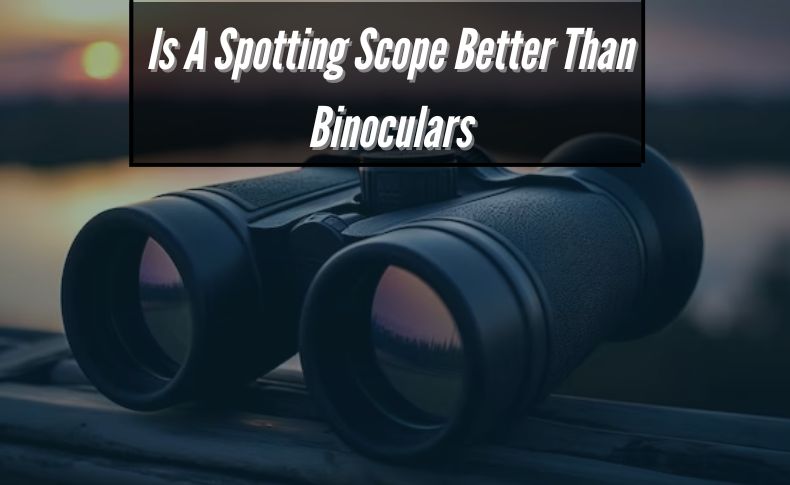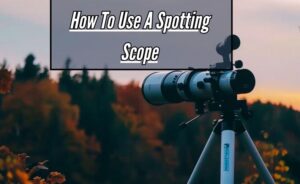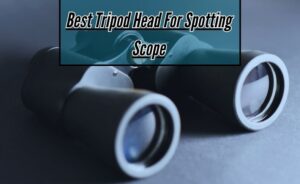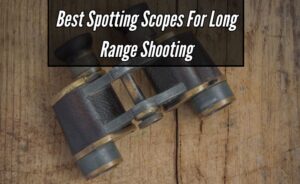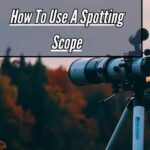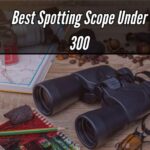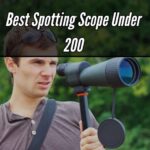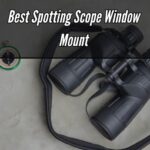Having the correct optical instrument can make all the difference while going on outdoor adventures or looking at far-off objects. Binoculars and spotting scopes are two popular options for long-distance viewing. Whose, however, is superior? Do binoculars offer advantages of their own or is a spotting scope preferable to them?
Is A Spotting Scope Better Than Binoculars? A spotting scope’s higher magnification and visual clarity make it superior to binoculars for long-distance observation, making it perfect for pursuits like birdwatching or target shooting. Binoculars, on the other hand, provide a larger field of view and are more adaptable and portable for everyday use.
In order to assist you choose wisely for your particular needs, we’ll examine the advantages and disadvantages of both spotting scopes and binoculars in this discussion. Understanding the differences between various optical devices can significantly improve your viewing experience, regardless of whether you enjoy watching birds, hunting, gazing at the stars, or simply being outside.
Optical Advantages: Spotting Scopes vs. Binoculars
When it comes to outdoor activities like birdwatching, wildlife observation, or even stargazing, choosing the right optical equipment can make a world of difference in your experience.
Two popular options are spotting scopes and binoculars, each with its unique set of advantages. In this comprehensive note, we’ll explore the optical advantages of both spotting scopes and binoculars, helping you decide which one suits your needs best.
Magnification and Image Quality:
One key advantage of spotting scopes lies in their superior magnification capabilities. These optical instruments often provide significantly higher magnification than binoculars, making them ideal for observing distant objects in detail.
Spotting scopes can zoom in on birds perched on a distant branch or celestial objects in the night sky, delivering crisp, clear images with less distortion. Binoculars, on the other hand, are limited in their amplification range, which can hinder their performance when observing distant or small subjects.
Light Gathering Ability:
Spotting scopes also excel in light-gathering ability due to their larger objective lenses. This feature allows them to collect more light, making them ideal for low-light conditions such as dawn or dusk.
The enhanced light-gathering ability of spotting scopes can reveal intricate details that might go unnoticed when using binoculars. This makes spotting telescopes a preferred choice for wildlife enthusiasts and astronomers who often venture out during the early morning or late evening hours.
Versatility and Portability:
While spotting scopes offer impressive magnification and image quality, they can be bulkier and heavier compared to monoculars. Binoculars, with their compact and lightweight design, offer greater versatility and portability.
They are easier to carry on hikes, birding expeditions, or other outdoor adventures where mobility is crucial. Binoculars are also more convenient for extended periods of handheld use, reducing the need for additional support equipment like tripods, which are often essential for spotting scopes.
Field of View:
Binoculars have a wider field of view compared to spotting scopes. This broader perspective allows users to scan large areas quickly, making them particularly useful for tracking fast-moving subjects such as birds in flight or animals on the move.
Spotting scopes, with their narrower field of view, are better suited for stationary or slow-moving subjects that require detailed examination.
Cost Considerations:
Cost can be a significant factor when deciding between spotting scopes and binoculars. Binoculars are generally more budget-friendly and offer good optical performance for the price.
Spotting telescopes, especially those with high-end features like image stabilization or superior coatings, can be considerably more expensive. Therefore, your budget may play a crucial role in determining which optical instrument aligns with your requirements.
Portability and Convenience: Binoculars vs. Spotting Scopes

When it comes to observing the world around us, whether for birdwatching, stargazing, or wildlife spotting, two popular optical tools often come into play: binoculars and spotting scopes. Both of these instruments offer unique advantages and disadvantages in terms of portability and convenience.
In this comprehensive note, we’ll explore the key differences and considerations between binoculars and spotting scopes, helping you make an informed choice based on your specific needs and preferences.
Size Matters:
One of the most noticeable distinctions between binoculars and spotting scopes is their size. Binoculars are inherently compact and lightweight, making them the ideal choice for enthusiasts who value mobility and spontaneous observations.
Their portability allows for quick deployment in the field, whether you’re hiking, traveling, or birdwatching on the move. Monoculars can be comfortably carried around your neck or in a small bag, ensuring you’re always ready to capture those unexpected moments in nature.
Unmatched Magnification and Stability
In contrast, spotting scopes are bulkier and heavier than binoculars, making them less convenient for spontaneous adventures. However, their primary advantage lies in their ability to deliver exceptionally high magnification.
Spotting scopes are particularly favored by birdwatchers, hunters, and astronomers who require intricate details or long-range observations. They often feature larger objective lenses and tripod mounts for enhanced stability, allowing for extended periods of comfortable viewing, making them an excellent choice for stationary or planned observations.
Specialized Functions:
Binoculars for Wide-Field Views binoculars are designed for wide-field views, allowing you to scan large areas effortlessly. This feature makes them perfect for birdwatching, sports events, or enjoying sweeping landscapes.
The binocular’s dual eyepiece design provides a natural, three-dimensional perspective, which adds to the immersive experience. Additionally, monoculars offer a wider field of view, making it easier to locate moving targets or celestial objects.
Spotting Scopes:
Precision and Detail Spotting scopes, on the other hand, excel in precision and detail. With their higher magnification, you can zoom in on distant subjects with remarkable clarity.
This makes them a preferred choice for activities that require accurate identification or recording of subtle features, such as identifying specific bird species or celestial objects. While spotting telescopes may lack the wide field of view of binoculars, they compensate with unparalleled image sharpness and detail.
The Middle Ground:
Compact Spotting Scopes For those seeking a compromise between the portability of binoculars and the magnification of spotting scopes, there is a middle ground—compact spotting scopes.
These instruments offer a balance between size and power, making them suitable for travelers and hikers who want a bit more magnification than monoculars can provide. Compact spotting telescopes are versatile, fitting in a backpack and allowing for moderate amplification and convenience.
Low Light Performance: Evaluating Spotting Scopes and Binoculars

Low light conditions can present a challenge for outdoor enthusiasts and wildlife observers, making it crucial to have spotting scopes and binoculars that excel in these conditions.
Whether you’re a birder, hunter, or stargazer, understanding the factors that influence low light performance in optics is essential for making informed purchasing decisions. In this article, we will delve into the key considerations for evaluating spotting scopes and binoculars in low light settings.
Aperture Size:
One of the primary factors affecting low light performance in spotting scopes and binoculars is the aperture size, often measured in millimeters (e.g., 50mm, 80mm).
A larger aperture allows more light to enter the optical system, resulting in brighter and clearer images in low light conditions. For observing in low light, consider choosing optics with larger apertures, but keep in mind that they can be bulkier and heavier.
Objective Lens Coatings:
High-quality coatings on the objective lenses are essential for enhancing low light performance. Optics with multi-coated or fully multi-coated lenses reduce light reflection and increase light transmission, resulting in improved image brightness and contrast in dim lighting. Look for terms like “fully multi-coated” when selecting spotting scopes and binoculars for low light use.
Exit Pupil Size:
The exit pupil size is a critical parameter to assess when evaluating low light performance. It’s calculated by dividing the aperture size by the magnification level.
A larger exit pupil (typically around 5-7mm) is more effective in low light because it matches the dilation of the human eye’s pupil in dim conditions. Make sure the optics you choose have an appropriate exit pupil for low light scenarios.
Low Light Accessories:
In addition to the optics themselves, consider the availability of low light accessories like tripod adapters, image stabilization technology, and low light reticles.
A sturdy tripod can eliminate image shake and enhance stability, while image stabilization technology can compensate for hand tremors, making it easier to spot subjects in low light. Low light reticles are particularly useful for hunters during dawn and dusk.
Optical Quality and Brand Reputation:
Optical quality plays a significant role in low light performance. Reputable brands invest in advanced optical technologies and quality control processes, ensuring better image clarity and reduced aberrations in challenging lighting conditions.
Before making a purchase, research the brand’s reputation and read user reviews to gauge the performance of the spotting scope or binoculars in low light situations
Cost Considerations: Spotting Scopes vs. Binoculars
When it comes to choosing optical equipment for various outdoor activities such as birdwatching, wildlife observation, or even stargazing, individuals often find themselves at a crossroads between spotting scopes and binoculars.
Both these devices serve their unique purposes and offer distinct advantages, but they also come with varying price tags. To make an informed decision, it’s crucial to weigh the cost considerations associated with spotting scopes and binoculars.
Initial Cost:
One of the most apparent differences between spotting scopes and binoculars is the initial cost. Binoculars, being smaller and more compact, are generally more affordable. They come in a wide range of prices, making them accessible to a broad spectrum of consumers.
On the other hand, spotting telescopes tend to be more expensive due to their larger size, enhanced optics, and specialized features. The initial investment for a quality spotting scope can be significantly higher.
Quality vs. Budget:
While binoculars offer affordability, it’s essential to consider the trade-off between quality and budget. Inexpensive binoculars may compromise on optics, resulting in lower image clarity and field of view.
Higher-end binoculars can provide exceptional image quality, but they may still fall short compared to the precision and clarity offered by spotting scopes. If you’re on a tight budget, monoculars may suffice for casual use, but for serious enthusiasts, investing in a quality spotting telescope could be a game-changer.
Versatility and Magnification:
Binoculars are versatile and great for a wide range of activities, from sports events to hiking. They’re often chosen for their portability and ease of use.
However, spotting scopes excel when it comes to long-range observation. With higher magnification options and the ability to attach additional accessories like digiscoping adapters, spotting telescopes are indispensable for detailed and distant viewing, but these advantages come with a higher price tag.
Long-Term Investment:
When considering the cost, it’s essential to view it as a long-term investment. Binoculars may seem like a more budget-friendly option initially, but if you eventually find yourself needing the capabilities of a spotting scope, you might end up spending more in the long run.
Choosing the right equipment from the start can save you from upgrading later and can be more cost-effective over time.
Accessories and Maintenance:
Another aspect to factor in is the cost of accessories and maintenance. Spotting scopes often come with a range of interchangeable eyepieces and tripod options, adding to the overall cost.
Additionally, their larger size may require more robust tripods, which can be an additional expense. Binoculars, being more compact, may have fewer accessory options and lower maintenance costs.
Factors to Consider: Making the Right Choice for Your Needs

In a world filled with countless options and choices, making the right decision for your specific needs can be a daunting task.
Whether you are selecting a new car, a career path, a financial investment, or even a meal at a restaurant, there are several critical factors to consider to ensure your choice aligns with your goals and preferences.
Define Your Objectives and Priorities:
Begin by clearly defining your objectives and priorities. What are you trying to achieve or accomplish with your choice?
Whether it’s finding a new job, purchasing a home, or selecting a vacation destination, understanding your goals will provide a clear direction for your decision-making process. Prioritizing your objectives can help you make choices that are in line with what truly matters to you.
Assess Your Budget and Resources:
Budget constraints play a significant role in making choices. Analyze your financial resources and set a realistic budget for your decision. Consider not only the upfront costs but also ongoing expenses.
Whether you’re buying a gadget, planning a wedding, or investing in a business venture, ensuring your choice fits within your financial capabilities is crucial for long-term satisfaction.
Gather Information and Research:
Thorough research is essential to make informed decisions. Take the time to gather relevant information about the options available to you. This may involve reading reviews, seeking advice from experts, consulting with peers, or conducting online research.
For instance, when choosing a new smartphone, consider factors like performance, camera quality, battery life, and brand reputation to make an informed choice.
Evaluate Long-Term Impact:
Consider the long-term impact of your decision. How will it affect your life or your future? For instance, when choosing a career path, think about your potential for growth, job stability, and work-life balance.
When selecting a place to live, contemplate factors like the local economy, educational opportunities, and quality of life. Evaluating long-term consequences can help you avoid making hasty decisions that may lead to regret later on.
Listen to Your Intuition and Gut Feeling:
While data and research are crucial, don’t underestimate the power of your intuition. Sometimes, your gut feeling can provide valuable insights that logic alone cannot.
If, after careful consideration, a choice feels right on an intuitive level, it may be worth trusting your instincts. However, it’s essential to balance intuition with rational thinking to ensure that your decision is well-rounded.
Conclusion
In conclusion, your own needs and tastes will determine if a spotting scope is superior to binoculars. Spotting scopes are perfect for activities like birdwatching and astronomy since they excel at giving increased magnification and sharper, more detailed views across vast distances.
However, monoculars are more portable and versatile for a larger variety of outdoor activities. Spotting telescopes and binoculars both offer distinctive advantages that cater to various conditions and tastes, thus the decision between the two should ultimately be based on the intended usage and personal preferences.
Frequently Asked Questions (Is A Spotting Scope Better Than Binoculars)
Which is more powerful binoculars or spotting scope?
Spotting scopes and binoculars have varied uses and levels of magnification. Spotting scopes are typically more powerful than binoculars in terms of magnification. Spotting telescopes can provide higher magnification, frequently exceeding 60x or even 80x, and are intended for long-distance observation. They are therefore perfect for pursuits requiring clarity and delineation at a distance, such as long-range target shooting, wildlife viewing, and birdwatching.
However, binoculars normally only have a 12x or 15x magnification, which is a lower amplification. They work better for activities like hiking, sports events, or other outdoor pursuits that call for a larger field of vision. Binoculars are a versatile option for a variety of scenarios because they are more portable and easier to wield for extended periods of time.
Are binoculars better than spotting scopes for bird watching?
Spotting scopes and binoculars are two useful instruments for bird viewing, each with a unique set of benefits. Because they are so portable and user-friendly, binoculars are great. With their broad field of vision, they facilitate the identification and tracking of birds in their native environments.
They are excellent for novices and all skill levels of birdwatchers alike, and may be used for a variety of purposes other than just bird watching. Observation Scopes, on the other hand, have a higher magnification and can allow you a closer look at far-off birds. When monitoring birds in marshes or from a distance, when it is not feasible to get up close, they are especially helpful. Despite having better amplification than binoculars, spotting telescopes are typically heavier and thicker, which makes them less portable.
Are spotting scopes better for astronomy than binoculars?
There are benefits to both binoculars and spotting scopes for astronomy. For detailed observations of far-off astronomical objects like planets and the moon, spotting scopes with larger objective lenses and higher magnification are often advantageous. They are also more comfortable for prolonged viewing sessions since they frequently have tilted eyepieces.
To scan the night sky and observe enormous astronomical objects like star clusters and the Milky Way, monoculars are a fantastic tool since they offer a larger field of view than other telescopes. Spotting telescopes and binoculars are ultimately a matter of preference and the particular objects you wish to view.
Can binoculars replace spotting scopes for target shooting?
Although they are helpful for target shooting, binoculars may not always be a suitable substitute for spotting scopes. Shooters can precisely judge shot placement and closely examine targets with a spotting scope’s increased magnification and sharper visuals, especially when using it at a longer range. On the other hand, monoculars are easier to tote about the range and more portable.
They work well for surveying the target area and picking up details, but they might not offer as much information as spotting telescopes when it comes to examining groups of bullet holes. In the end, a shooter’s tastes and unique requirements during target practice will determine whether they choose to use spotting scopes or binoculars.
Are binoculars more portable than spotting scopes?
Yes, in general, binoculars are easier to carry than spotting scopes. Because of their small size and lightweight, binoculars are convenient to bring about for outdoor pursuits like birdwatching, hiking, and sporting events. They fit neatly into a tiny purse or pocket or can be worn around the neck.
However, spotting telescopes are heavier and less portable due to their bigger size and frequent inclusion of extra attachments like tripods. For certain pursuits, such as astronomy or birdwatching, spotting scopes offer a greater magnification and better images; nonetheless, Monoculars strike a fair compromise between mobility and practicality for on-the-go observation.
Do spotting scopes have a wider field of view than binoculars?
The field of view of spotting scopes is typically not larger than that of binoculars. Users may see a greater area at once with Monoculars since they are specifically made to offer a wider field of view. For tasks like scanning landscapes or birdwatching, this larger range of view is useful.
On the other hand, spotting telescopes usually have narrower fields of view and higher magnification, which are advantageous for seeing distant objects in more clarity and detail. Binoculars are recommended when a wider viewpoint is required, such as when monitoring wildlife or taking in panoramic views, even though spotting telescopes are excellent at capturing sharp photos of far-off objects.

